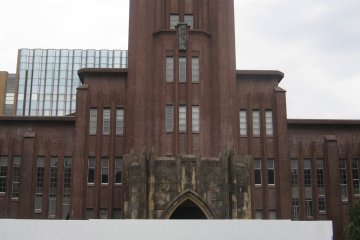Did you know that sometimes you can find out which deity is worshipped at a shrine by simply looking at the shrine’s name? Yushima Tenman-gu is such a shrine. It's only a short walk from Ueno Park, and many people go there to pray in hopes of passing an exam or for good marks in school. So how do you know this by just reading “Yushima Tenman-gu”?
While most shrine names end in jinja (神社) or jingu (神宮), which both mean “shrine”, there are also several tenman-gu (天満宮) found in Japan. These shrines are all dedicated to the scholar and poet Sugawara no Michizane, who lived from 845 until 903 during the Heian period. Sugawara as well as his grandfather and father served the court, and as governor the younger Sugawara gained the favor of Emperor Uda. When the emperor abdicated, Sugawara’s position became vulnerable, and he was demoted in 901. Following Sugawara's death two years later, the land faced multiple disasters, including heavy rains and floods, and the subsequent deaths of Emperor Daigo's sons.
In order to calm this angry spirit, the imperial court built the Kitano Tenman shrine in Kyoto and dedicated it to Sugawara. Seventy years later, the deceased scholar was also deified and became known as “Tenjin.” The long form of this deity is “Tenman-Tenjin,” so every shrine that is called Tenman-gu is a shrine dedicated to Tenjin, the deity of learning. Yushima Tenman-gu was originally built for the worship of a mythical deity and established in 458. The spirit of Sugawara was additionally enshrined in 1355.
Yushima Tenman-gu is located close to the University of Tokyo, so many students go there to pray for success in their exams. They are especially seen at the beginning of the year as they pray for the entrance exams and the new school year, which starts in April. You can also buy small wooden votive tablets called ema (絵馬), write your wish on them and hang them next to the shrine. I saw many that read “Please let me pass my exam!” and among all these prayers for success, I decided to get myself a fortune slip (omikuji おみくじ).
Today was my lucky day. Even though I have no upcoming exam, I got dai kichi (大吉), meaning the greatest of blessings. To understand what is written on the fortune slips and how to worship at a shrine, you should read the guide on Etiquette at Shrines and Temples!
Yushima Tenman-gu is a ten-minute walk from Ueno Station. If you are looking for accommodation in that area, I recommend HOTEL MYSTAYS Ueno-Iriyaguchi. From there you have easy access to the shrine and other places of interest, such as the Hachiko Statue or Asakusa Kaminarimon.














